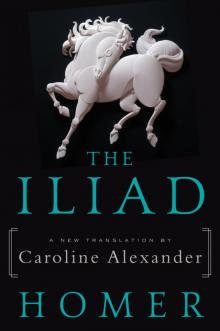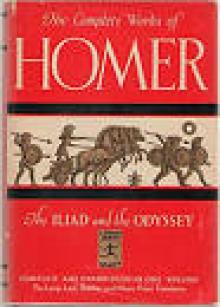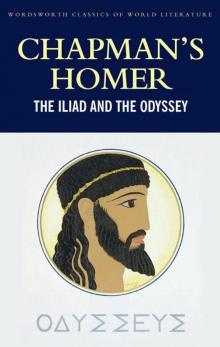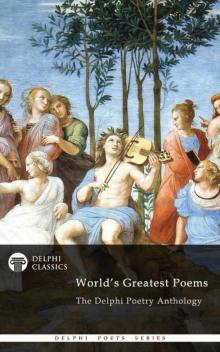The Iliad (Penguin Classics) Read online
THE ILIAD
The Greeks believed that The Iliad was composed by HOMER. In our ignorance of the man, his life and his work, we are free to believe it or not. Received opinion dates him c. 700 BC and places him in Ionia, the Greek-inhabited coast and islands off central western Turkey. The Greeks believed the same man composed The Odyssey.
E. V. RIEU, editor of the Penguin Classics from 1944 to 1964, was a scholar of St Paul’s School and of Balliol College, Oxford. He joined Methuen in 1923 and was Managing Director from 1933 to 1936, and then Academic and Literary Adviser. He was President of the Virgil Society in 1951 and Vice-President of the Royal Society of Literature in 1958. He was awarded an honorary D.Litt. by Leeds University in 1949 and the CBE in 1953. Among his publications are The Flattered Flying Fish and Other Poems, and translations of The Odyssey, The Iliad, Virgil’s Pastoral Poems, the Voyage of Argo by Apollonius of Rhodes and The Four Gospels in the Penguin Classics. He died in 1972.
D. C. H. RIEU, his son, read Classics and English at Queen’s College, Oxford. He joined the West Yorkshire Regiment and was wounded at Cheren in 1941, and awarded the Military Cross. He was Headmaster of Simon Langton Grammar School, Canterbury, from 1955 to 1977. He translated the Acts of the Apostles in the Penguin Classics, and revised his father’s Odyssey, in consultation with Dr Peter Jones, and with him has revised his father’s translation of The Iliad. On retirement he worked for Cruse Bereavement Counselling and for the Samaritans. He has been in Subud for many years, and has written books and articles about it, beginning with A Life Within a Life in 1963.
A Cambridge graduate with a London doctorate on Homer, PETER JONES was a schoolteacher and senior lecturer in Classics at the University of Newcastle upon Tyne. He is now a writer, broadcaster and journalist. Appointed MBE in 1983, he is Spokesman for the national Co-ordinating Committtee for Classics and founder with Jeannie Cohen of the charity Friends of Classics. He wrote the QED and Eureka series for the Daily Telegraph, both now published by Duckworth as Learn Latin and Learn Ancient Greek. Duckworth have also published his Classics in Translation (another Telegraph series), Ancient and Modern (from his weekly column in the Spectator) and An Intelligent Person’s Guide to Classics. He has co-authored the Reading Greek and Reading Latin series for Cambridge, and published books, articles and commentaries on Homer.
HOMER
The Iliad
Originally translated by E. V. RIEU
Revised and updated by
PETER JONES with D. C. H. RIEU
Edited with an Introduction and Notes by
PETER JONES
PENGUIN BOOKS
PENGUIN BOOKS
Published by the Penguin Group
Penguin Books Ltd, 80 Strand, London WC2R 0RL, England
Penguin Putnam Inc., 375 Hudson Street, New York, New York 10014, USA
Penguin Books Australia Ltd, 250 Camberwell Road, Camberwell, Victoria 3124, Australia
Penguin Books Canada Ltd, 10 Alcorn Avenue, Toronto, Ontario, Canada M4V 3B2
Penguin Books India (P) Ltd, 11, Community Centre, Panchsheel Park, New Delhi – 110 017, India
Penguin Books (NZ) Ltd, Cnr Rosedale and Airborne Roads, Albany, Auckland, New Zealand
Penguin Books (South Africa) (Pty) Ltd, 24 Sturdee Avenue, Rosebank 2196, South Africa
Penguin Books Ltd, Registered Offices: 80 Strand, London WC2R 0RL, England
www.penguin.com
E. V. Rieu’s translation first published 1950
This revised translation first published 2003
1
Revised translation copyright © the Estate of the late E. V. Rieu, and Peter Jones, 2003
Introduction to the 1950 Edition copyright © E. V. Rieu, 1950
Introduction, Notes and other editorial matter copyright © Peter V. Jones, 2003
All rights reserved
The moral rights of the translators and editor have been asserted
Except in the United States of America, this book is sold subject to the condition that it shall not, by way of trade or otherwise, be lent,
re-sold, hired out, or otherwise circulated without the publisher’s prior consent in any form of binding or cover other than that in which it is published and without a similar condition including this condition being imposed on the subsequent purchaser
ISBN: 978-0-14-192043-6
Contents
Foreword
Introduction
Introduction to the 1950 Edition
Notes on this Revision
The Main Characters
Further Reading
Maps
1. A reconstruction of Homer’s imagined battlefields
2. The Troad
3. Trojan places and contingents
4. Homeric Greece
5. Greek contingents at Troy
Preliminaries
The Iliad
1. PLAGUE AND WRATH
2. A DREAM, A TESTING AND THE
CATALOGUE OF SHIPS
3. A DUEL AND A TROJAN VIEW OF
THE GREEKS
4. THE OATH IS BROKEN AND
BATTLE JOINED
5. DIOMEDES’ HEROICS
6. HECTOR AND ANDROMACHE
7. AJAX FIGHTS HECTOR
8. HECTOR TRIUMPHANT
9. THE EMBASSY TO ACHILLES
10. DIOMEDES AND ODYSSEUS:
THE NIGHT ATTACK
11. ACHILLES TAKES NOTICE
12. HECTOR STORMS THE WALL
13. THE BATTLE AT THE SHIPS
14. ZEUS OUTMANOEUVRED
15. THE GREEKS AT BAY
16. THE DEATH OF PATROCLUS
17. THE STURGGLE OVER
PATROCLUS
18. ACHLLES’ DECISION
19. THE FEUD ENDS
20. ACHILLES ON THE RAMPAGE
21. ACHILLES FIGHTS THE RIVER
22. THE DEATH OF HECTOR
23. THE FUNERAL AND THE GAMES
24. PRIAM AND ACHILLES
Appendices
1. A Brief Glossary
2. Omitted Fathers’ Names
Index
Foreword
E. V. Rieu’s translations of Homer, The Odyssey (1946, the first Penguin Classic) and The Iliad (1950), spoke to millions. Never before had this greatest of ancient Greek poets seemed so vivid, so immediate, so approachable to so wide an English-speaking audience.
But popular translations must move with the times. Cultural and linguistic idioms change. Research advances understanding. So in 1988 Penguin invited Dominic Rieu to revise his father’s Odyssey, and I had the pleasure of acting as consultant. Now the roles have been reversed, and Dominic has acted as consultant for my revision of his father’s Iliad. He has been an enthusiastic supporter of the project, a wise, perceptive and stimulating critic, restraining and encouraging in equal measure.
This is a revision, not a new translation, but it is a thorough revision, involving more than updating idiom and making technical adjustments in the light of recent scholarship (for which see Notes on this Revision, pp. lxiii–lxv). Consequently, readers can expect to find more changes in Rieu’s Iliad than in Dominic Rieu’s revision of his Odyssey. I have also written a new Introduction, added chapter summaries, marginal notes, appendices and an Index, and revised Rieu’s list of human and divine characters. The commentaries written by M. M. Willcock and W. Leaf and the commentary series edited by G. S. Kirk have never been far from my elbow (see Further Reading) .
My best thanks go to Andrew Morley for the maps and the sketch of the plain of Troy – Ilium, the Greek camp and surrounding environs (sea, rivers, Mount Ida, etc.) – as Homer might possibly have envisaged it.
PVJ
Newcastle upon Tyne
April 2002
Introduction
READING HOMER’S ILIAD
The Iliad is the first work of Western literature, a 15,000-line epic poem composed c. 700 BC, so called because it tells of an incident that occurred during the Greek siege of Ilium, a town in the region of Troy (modern north-west Turkey).*
A reader who wishes to sample it can use the summaries at the start of each book to keep abreast of the plot. Book 1, the quarrel between Agamemnon and Achilles, explains Achilles’ anger and withdrawal from battle. The duel between Menelaus and Hector and the subsequent APHRODITE-Paris-Helen scene in Book 3 introduce the Trojan enemy and the reason for the Greek siege. The Hector-Andromache scene in Book 6 puts the Trojan hero Hector in perspective. Book 9 is central, because the Iliad hinges on Achilles’ rejection here of Agamemnon’s offer of reconciliation. The seduction of ZEUS in Book 14 shows Homer’s touch at its lightest. At this point the epic becomes more and more centred on Achilles, as his personal tragedy unfolds. Books 16, 18 (the death of Patroclus and Achilles’ decision to return to battle) and 22–24 (the death of Hector, Patroclus’ burial and the return of Hector’s body) form the irreducible kernel.
AN OUTLINE PLOT OF THE ILIAD
Trojan Paris seduced Menelaus’ wife Helen and took her back to Ilium. Menelaus appealed to his brother Agamemnon, and together they raised an expedition to bring her back. The Iliad is set in the last year of the Greek siege of Ilium and begins with a quarrel.
Agamemnon, leader of the Greek expeditionary force, has been given as booty the daughter of a local priest of APOLLO. He is forced to return her and demands a replacement. After a furious quarrel with Achilles, he takes Briseis, Achilles’ prize, prompting Achilles and his close companion Patroclus to walk out of the fighting. Achilles’ divine mother THETIS wrings a promise out of ZEUS, king of the gods, that the Greeks will start to lose, so that Achilles will be welcomed back and the insult made good. This immediately causes trouble with ZEUS’ wife HERA, who supports the Greeks (Book 1).
In Books 2–8, Homer lays the immediate quarrel aside and presents the broader picture – the Greek and Trojan combatants on earth, and the gods on Olympus. We see Agamemnon testing the morale of the troops and making a fool of himself (2); Trojan Paris defeated in a duel with Menelaus, but saved by his patron goddess APHRODITE (3); the gods most hostile to Troy, HERA and ATHENE, getting the fighting started again (4); the Greek hero Diomedes routing the Trojans, and even wounding APHRODITE and the war-god A RES (5); Troy’s greatest fighter Hector in moving conversation with his wife Andromache and their child (6); Hector fighting an inconclusive duel with Ajax, and the Greeks building a defensive wall and ditch (7); and ZEUS tipping the scales in favour of the Trojans, who drive the Greeks right back behind their new defences and camp out for the night on the plain (8).
Agamemnon now acknowledges that he was wrong to insult Achilles and agrees to send an embassy to him with massive compensation to beg him to return. Odysseus, Phoenix and Ajax lead the embassy, but to their amazement Achilles rejects them. Achilles’ tragedy begins here (Book 9).
In Books 10–15, we see Homer preparing the groundwork for the fatal entry of Patroclus, Achilles’ close companion, into battle. Diomedes and Odysseus go on a night expedition into the Trojan camp and steal the famous horses of Rhesus (10); Agamemnon enjoys a brief solo feat of arms, but the Greeks are driven back. Achilles sends Patroclus to find out what is happening, and wise old Nestor suggests to Patroclus that, if Achilles will not return to the fighting, Patroclus might, dressed in Achilles’ armour (11). Meanwhile the Trojans force home their attack on the Greek defences. Part of the parapet is torn away; Hector smashes down the gate and the Trojans pour through (12). ZEUS, assuming the Trojans will now win, turns his attention elsewhere, and POSEIDON takes the opportunity to rally the Greeks (13). HERA keeps ZEUS occupied by making love to him. The Trojans are routed (14). ZEUS wakes up and, enraged, threatens the gods with violence if they intervene anymore. POSEIDON withdraws, APOLLO destroys the Greek defences and Hector leads the Trojans right up to the Greek ships (15).
Patroclus now returns to Achilles and repeats Nestor’s suggestion that he go into battle dressed in Achilles’ armour. Achilles (fatally) agrees. In a great solo feat of arms Patroclus drives the Trojans right back, but is stripped of his armour by APOLLO and killed by Hector (Book 16). A fierce battle breaks out over Patroclus’ body, and Hector dons Patroclus’ (i.e. Achilles’) armour. The Greeks retreat with Patroclus’ body (Book 17). Achilles hears about Patroclus’ death, acknowledges it is entirely his fault and announces that he will have his revenge on Hector. THETIS tells him he will die immediately afterwards, and Achilles accepts the price. Herein lies his tragedy. HEPHAESTUS makes new armour for Achilles, including the famous shield (Book 18).
Agamemnon and Achilles are reconciled and the gifts delivered to Achilles, who is now urgent for revenge on Hector (Book 19). He goes on such a murderous rampage that POSEIDON has to save Aeneas from him, and APOLLO whisks Hector away to safety too (Book 20) . The River-god tries to drown Achilles because he has blocked up the River’s channels with the dead; even the gods fall to fighting each other (Book 21).
Achilles isolates Hector and kills him. Against all custom, he keeps and mutilates the body (Book 22). Patroclus is cremated, and Achilles holds funeral games (Book 23). Still unable to reconcile himself to events, Achilles drags Hector’s body futilely round Patroclus’ grave-mound. The gods agree Achilles has gone too far and arrange for Hector’s father Priam, King of Troy, to supplicate Achilles for the return of Hector’s body. In the night encounter in Achilles’ quarters, old Priam succeeds. The Iliad ends with laments for Hector, and his burial (Book 24).
The Iliad ends there, but Homer has still left us with a clear notion of what the immediate future holds – death for Achilles and destruction for Ilium.
THE FOCUS OF THE ILIAD
As Aristotle saw, Homer decided not to work through the whole Trojan War year by year, but to direct the action of the epic round a single theme – the anger of Achilles announced in the first line of the epic, which brought endless sufferings to his own side (as Homer at once points out) and ultimately himself. As a result, the Iliad is distinguished by a tight economy of action. For example, four-fifths of the action occurs on a mere four days and intervening nights (the whole of Books 11–18 takes place over only twenty-four hours). The story centres round the aristocratic heroes, not the general mass of troops. Very many heroes are named, but Homer selects about twenty characters in all from both sides to concentrate on (including Trojan women). The human action takes place either in or around the Greek camp on the beach, or in Ilium, or on the battlefield, while the divine action takes place on Mount Olympus or one of the mountains around Troy, for example Mount Ida (see map 1). Nor are the Greeks and Trojans significantly differentiated by Homer. For the sake of the story they worship the same gods, speak the same language and share the same assumptions and values. Both armies desire to end the war and live with their families at home, in peace, though the Greeks, as aggressors on a mission, come over as more single-minded than the Trojans, defending their homes, for whom there is more to life than battle.
At the same time, however, Homer creates the impression that he is covering the whole war, and even the periods before and after it. In the course of the Iliad, for example, and quite outside the time-frame of the story itself, we learn that the goddess THETIS married the mortal Peleus, producing Achilles. Homer gives us a charming picture of Achilles as a baby, an insight into his education, and how his close companion Patroclus – so crucial to the Iliad – came to live in his household.
Further, we are told that Paris, handsome son of Priam, selected APHRODITE as the winner of the golden apple - Homer does not mention the apple – and was granted as his reward the most beautiful woman in the world, Helen, wife of Menelaus, ruler of Sparta in Greece. On a visit to Sparta, Pa
ris broke all rules of hospitality, seduced Helen and took her back to Ilium, much to the disgust of his brother Hector, Troy’s greatest fighter. Menelaus then appealed to his brother Agamemnon, and together they raised an expedition to retrieve Helen. To judge from Homer’s catalogue of ships, it consisted of 29 contingents led by 44 commanders from 175 Greek localities in 1,186 ships containing (one may guess) 100,000 men. The expedition set off with favourable omens.1
We are informed that, when the expedition landed in Troy, Protesilaus was the first man killed as he leapt ashore; that Menelaus and Odysseus tried to settle the matter by negotiation; that they were rejected – one Trojan even thought Menelaus should be murdered then and there – and for nine long years the Greeks laid siege to Ilium, without success. Homer looks back to a few incidents from this period, but there was really very little to say about it. He could not construct a convincing epic for a Greek audience about the Greeks’ nine-year inability to take Troy. Nor could any Greek: all other accounts of the Trojan War struggle to fill these years convincingly.
There is, however, one exception. The seeds of Homer’s Iliad lie in events which took place immediately before the story starts – the Greek raids led by Achilles on neighbouring Trojan towns for the purpose of aggrandizement. Two significant towns catch Homer’s especial attention: Thebe, where Achilles captured the girl Chryseis over whose ownership the Iliad begins; and Lyrnessus, where Achilles captured his favourite woman Briseis. Further, Homer lays emphasis on the division of spoils that took place after such raids, and the resentment Achilles felt at its unfairness.2
The Iliad, in other words, seems to cover much more than a few days during the last year of the Trojan War. In the first work of Western literature, we find an economy and focus combined with a breadth of vision that have informed narrative literature ever since.

 The Odyssey
The Odyssey The Iliad
The Iliad The Iliad (Trans. Caroline Alexander)
The Iliad (Trans. Caroline Alexander) Complete Works of Homer
Complete Works of Homer The <I>Odyssey</I>
The <I>Odyssey</I> The Iliad and the Odyssey (Classics of World Literature)
The Iliad and the Odyssey (Classics of World Literature) Troy
Troy The Iliad (Penguin Classics)
The Iliad (Penguin Classics) Delphi Poetry Anthology: The World's Greatest Poems (Delphi Poets Series Book 50)
Delphi Poetry Anthology: The World's Greatest Poems (Delphi Poets Series Book 50)